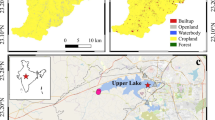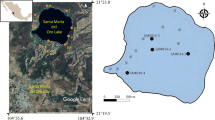Abstract
This multi-disciplinary investigation documents the longterm effects of atmospheric pollution of metals and acids on a geologically sensitive catchment in the Šumava Mountains, southwestern Czech Republic, a region with a long history of human disturbance. A 30 cm long sediment core (I) from Čertovo Lake was analyzed for natural and artifical radionuclides, metals, diatoms, chrysophytes, and pollen in sediments accumulated during the last 200 years. A second core (II), extending to 95 cm, included sediment judged to be free of atmospheric deposition of pollutants associated with the Industrial Revolution. Chronostratigraphic markers include several changes in the pollen assemblages corresponding to well-documented changes in land-use, and distinct distributions of 137Cs, 134Cs and 241Am from weapons testing and the 1986 nuclear accident at Chernobyl, Russia. These markers corroborate the 210Pb dating and, together, produce a reliable chronology extending back nearly to 1800 A.D.
Stratigraphic profiles of Cu, Pb, and Zn in Core I are unlike any previously reported in the literature. Concentrations of Cu, Pb, and Zn remain generally above 100, 400, and 200 μg g-1, respectively, for the 200 years represented by Core I. These values are unusually high for sediments from a watershed with no known heavy-metal ore bodies. Accumulation rates for Cu, Pb, and Zn, which include both atmospheric and watershed contributions, are also high (ca 1, > 1 and > 1 μg cm-2 yr-1, respectively) for the same period, although the anthropogenic contribution of Zn rose from nearly zero at 1800 A.D. The Cu and Pb accumulation rates rose dramatically about 1640 A.D.
Accumulation rates of anthropogenically-derived Be, a relatively abundant element in the soft coals of the region, are also elevated by about 0.01 μg cm-2 yr-1 in sediments of this period. Vanadium accumulation rates increased only since 1980 A.D., presumably along with increased consumption of oil.
Diatom assemblages illustrate that the lake was acidic (pH between 4.5 and 5) through at least the past 200 years. The pH declined significantly (from ca 5 to 4) between 1960 and 1985 with a slight increase to 4.5 in the last few years. Recent diatom and chrysophyte assemblages suggest high trace metal concentrations, consistent with the present lake-water chemistry.
Similar content being viewed by others
References
Appleby, P. G. & F. Oldfield, 1978. The calculation of 210Pb dates assuming a constant rate of supply of unsupported 210Pb to the sediment. Catena 5: 1–8.
Appleby, P. G., P. Nolan, D. W. Gifford, M. J. Godfrey, F. Oldfield, N. J. Anderson & R. W. Battarbee, 1986. 210Pb dating by low background gamma counting. Hydrobiologia 141: 21–27.
Appleby, P. G., N. Richardson & P. J. Nolan, 1991. 241Am dating of lake sediments. Hydrobiologia 214: 35–42.
Battarbee, R. W., 1973. A new method for the estimation of absolute microfossil numbers, with special reference to diatoms. Limnol. Oceanogr. 18: 647–653.
Battarbee, R. W., 1984. Diatom analysis and the acidification of lakes. Phil. Trans. r. Soc. (London), Series B, 305: 451–477.
Battarbee, R. W., J. Mason, J. Renberg & J. F. Talling (eds), 1990. Paleolimnology and Lake Acidification. The Royal Society, London, 445 pp.
Behre, K.-E., 1981. The interpretation of anthropogenic indicators in pollen diagrams. Pollen et Spores 23: 225–245.
Berglund, B. E., 1985. Early agriculture in Scandinavia: research problems related to pollen-analytical studies. Norw. Arch. Rev. 18: 77–105.
Binford, M. W., J. S. Kahl & S. A. Norton, in press. Interpretation of 210Pb profiles and tests of the CRS dating model in PIRLA project lake sediment cores. J. Paleolimnol.
Birks, H. J. B., J. M. Line, S. Juggins, A. C. Stevenson & C. J. F. ter Braak, 1990. Diatoms and pH reconstructions. Phil. Trans. r. Soc. (London), Series B, 327: 263–278.
Blau, J., 1932. Geschichte der künischen Freibauern in Böhmerwalde, Plzeň, Czech., 661 pp.
Buckley, D. E. & R. E. Cranston, 1971. Atomic absorption analyses of 18 elements from a single decomposition of aluminosilicate. Chem. Geol. 7: 273–284.
Camburn, K. E., J. C. Kingston & D. F. Charles (eds), 1984–1986. PIRLA Diatom Iconograph, PIRLA Unpublished Report Series 3 53 plates, Indiana University, Bloomington, In, USA.
Carrignan, R. & A. Tessier, 1985. Zinc deposition in acid lakes-the role of diffusion. Science 228: 1524–1526.
Charles, D. F., R. W. Battarbee, I. Renberg, H. van Dam & J. P. Smol, 1989. Paleoecological analysis of diatoms and chrysophytes for reconstructing lake acidification trends in North America and Europe. In S. A. Norton, S. E. Lindberg & S. L. Page (eds) Acid precipitation, Vol. 4, Soils, Aquatic Processes and Lake Acidification. Springer-Verlag, N.Y.: 207–276.
Charles, D. F., M. W. Binford, E. T. Furlong, R. A. Hites, M. J. Mitchell, S. A. Norton, F. Oldfield, M. J. Paterson, J. P. Smol, A. J. Uutala, J. R. White, D. R. Whitehead & R. J. Wise, 1990. Paleoecological investigation of recent lake acidification in the Adirondack Mountains, N.Y. J. Paleolimnol. 3: 195–241.
Cronberg, G., 1990. Recent acidification and changes in the subfossil chrysophyte flora of lakes in Sweden, Norway and Scotland. Phil. Trans. r. Soc. (London), Series B. 327: 289–293.
Davis, R. B., C. T. Hess, S. A. Norton, D. W. Hanson, K. D. Hoagland & D. S. Anderson, 1984. 137Cs and 210Pb dating of sediments from soft-water lakes in New England (USA) and Scandinavia, a failure of 137Cs dating. Chemical Geology 44: 151–185.
Davis, R. B. & D. S. Anderson, 1985. Methods of pH calibration of sedimentary diatom remains for reconstructing history of pH in lakes. Hydrobiol. 120: 69–87.
Dixit, S. S., A. S. Dixit & J. P. Smol, 1989. Relationships between chrysophyte assemblages and environmental variables in seventy-two Sudbury lakes, as examined by canonical correspondence analysis (CCA). Can. J. Fish. Aquat Sci. 46: 1667–1676.
Dixit, S. S., A. S. Dixit & J. P. Smol. 1991. Multivariable environmental inferences based on diatom assemblages from Sudbury (Canada) lakes. Fresh Water Biology.
Erdtman, G., B. Berglund & J. Praglowski, 1961. An introduction to a Scandinavian Pollen Flora. Almqvist & Wiksells, Uppsala.
Faegri, K. & J. Iversen, 1975. Textbook of Pollen Analysis. Hafner Publishing Co., New York, 237 pp.
Frič, A., 1872. Ueber die Fauna der Böhmerwaldseen. Sitz. k. bohm. Ges. Wiss. (July 15, 1871, Praha): 3–12.
Frič, A. & V. Vávra, 1898. Research on the two Šumava lakes, Černé and Čertovo. Archiv p. přirod. výzkum Čech X: 1–66 (in Czech).
Hartmann, H. & C. Steinberg, 1986. Mallomonadacea (Chrysophyceae) scales: Early biotic paleoindicators of lake acidification. Hydrobiol. 143: 87–91.
Hustedt, F., 1939. Systematische und ekologische Untersuchungen über die Diatomeen-Flora von Java, Bali und Sumatra. Archiv für Hydrobiologie Supplement 16: 1–155, 274–394.
Jacobson, H. A. & D. R. Engstrom, 1989. Resolving the chronology of recent lake sediments: An example from Devil's Lake, North Dakota. J. Paleolimnol. 2: 81–97.
Komárek, J., 1882. Prince Hohenzollern forests of the Eisenstein district. Politik, Praha (in Czech) 70 pp.
Miller, L. M., 1991. Sediment chemistry of Černé, Čertovo, and Prášilské Lakes in the Šumava Mountains, Czechoslovakia. Unpublished M.Sc. Thesis. University of Maine, Maine, USA, 115 pp.
Norton, S. A. & J. S. Kahl, 1991. Progress in understanding the chemical stratigraphy of metals in lake sediments in relation to acidic precipitation. Hydrobiol. 214: 77–84.
Norton, S. A., P. J. Dillon, R. D. Evans, G. Mierle & J. S. Kahl, 1990. The history of atmospheric pollution and deposition of Cd, Hg, and Pb in North America. In S. E. Lindberg, A. L. Page & S. A. Norton (eds), Sources, Deposition, and Canopy Interactions, Vol. 3, Chapter 4, Advances in Envir. Sc., Acidic Precip. Springer-Verlag, New York: 73–102.
Nožička, J., 1957. A survey of the development of our forests. SZN, Praha (in Czech) 459 pp.
Oldfield, F. & P. G. Appleby, 1984. Empirical testing of 210Pb-dating models. In E. Y. Hayworth & J. W. G. Lund (eds), Lake Sediments and Environmental History, Univ. Minn. Press, Minneapolis, MN: 93–124.
Pelíšek, J., 1971. The soils from the wooded areas of Sumava. Lesnictvi. 17: 715–734 (in Czech).
Rybniček, K. & E. Rybničková 1968. The history of flora and vegetation on the Blato mire in southeastern Bohemia, Czechoslovakia (Paleoecological Study). Folia Geobot. Phytotax. 3: 117–142.
Sofron, J. & J. Štěpán, 1971. Vegetation of the Šumava corries. CSAV, RMP, 81: 1–56 (in Czech).
Smol, J. P., 1983. The paleophycology of a high arctic lake near Cape Herschel, Ellesmere Island. Can. J. Bot. 61: 2195–2204.
Smol, J. P., 1985. The ratio of diatom frustules to chrysophycean statospores: A useful paleolimnological index. Hydrobiol. 123: 199–208.
Smol, J. P., 1986. Chrysophycean microfossils as indicators of lake water pH. In J. P. Smol, R. W. Battarbee, R. B. Davis & J. Meriläinen (eds), Diatoms and Lake Acidity. Junk, Dordrecht: 257–287.
Stiess, B. 1961. Alžbetin glassworks in Šumava. Sklář and Kevamik, 11: 319–321 (in Czech).
Stockmarr, J., 1972. Tablets with spores used in absolute pollen analysis. Pollen et Spores 13: 615–621.
Veselý, J., 1947. A report on the damages to the natural reserves in Šumava. Ochrana prirody 2: 85–86 (in Czech).
Veselý, J., 1990. Investigation of the nature of the Šumava lakes. Report of Geological Survey Prague, Czechoslovakia,. 49 pp.
Veselý, J., P. Benes & K. Ševčik, 1989, Occurrence and speciation of beryllium in acidified freshwaters: Wat. Res. 23: 711–717.
Veselý, J. & V. Majer, 1992. The major importance of nitrate increase for the acidification of two lakes in Bohemia. Documenta Ist. ital. Idrobiol. 32: 83–92.
Wagner, P., 1897. Die seen des Böhmerwaldes. Duncker and Humbolt, Wiss.-Veroff. Ver, Leipzig, 88 pp.
Ward, H. B., 1899. The fresh-water biological stations of the world. Science 9: 497–508.
Author information
Authors and Affiliations
Rights and permissions
About this article
Cite this article
Vesely, J., Almquist-Jacobson, H., Miller, L.M. et al. The history and impact of air pollution at Čertovo Lake, southwestern Czech Republic. J Paleolimnol 8, 211–231 (1993). https://doi.org/10.1007/BF00177857
Received:
Accepted:
Issue Date:
DOI: https://doi.org/10.1007/BF00177857




